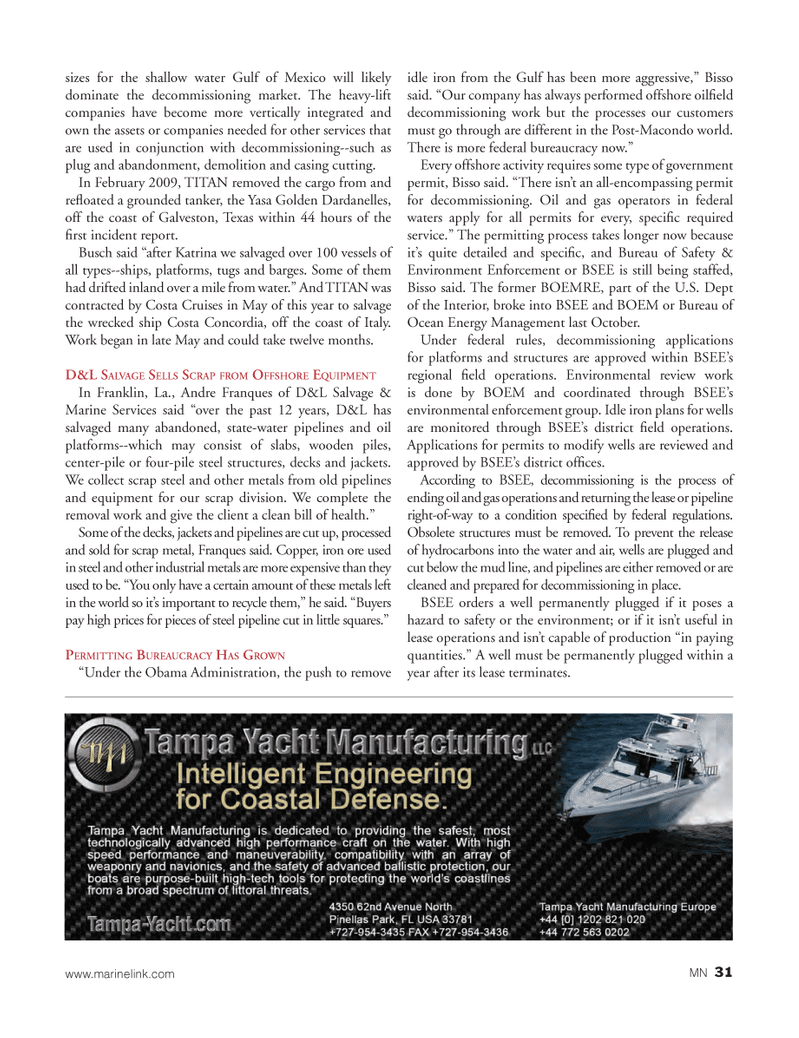
Page 31: of Marine News Magazine (August 2012)
Salvage & Recovery
Read this page in Pdf, Flash or Html5 edition of August 2012 Marine News Magazine
sizes for the shallow water Gulf of Mexico will likely dominate the decommissioning market. The heavy-lift companies have become more vertically integrated and own the assets or companies needed for other services that are used in conjunction with decommissioning--such as plug and abandonment, demolition and casing cutting.In February 2009, TITAN removed the cargo from and reß oated a grounded tanker, the Yasa Golden Dardanelles, off the coast of Galveston, Texas within 44 hours of the Þ rst incident report. Busch said Òafter Katrina we salvaged over 100 vessels of all types--ships, platforms, tugs and barges. Some of them had drifted inland over a mile from water.Ó And TITAN was contracted by Costa Cruises in May of this year to salvage the wrecked ship Costa Concordia, off the coast of Italy. Work began in late May and could take twelve months. D&L SALVAGE SELLS SCRAP FROM OFFSHORE EQUIPMENT In Franklin, La., Andre Franques of D&L Salvage & Marine Services said Òover the past 12 years, D&L has salvaged many abandoned, state-water pipelines and oil platforms--which may consist of slabs, wooden piles, center-pile or four-pile steel structures, decks and jackets. We collect scrap steel and other metals from old pipelines and equipment for our scrap division. We complete the removal work and give the client a clean bill of health.Ó Some of the decks, jackets and pipelines are cut up, processed and sold for scrap metal, Franques said. Copper, iron ore used in steel and other industrial metals are more expensive than they used to be. ÒYou only have a certain amount of these metals left in the world so itÕs important to recycle them,Ó he said. ÒBuyers pay high prices for pieces of steel pipeline cut in little squares.Ó PERMITTING BUREAUCRACY HAS GROWN ÒUnder the Obama Administration, the push to remove idle iron from the Gulf has been more aggressive,Ó Bisso said. ÒOur company has always performed offshore oilÞ eld decommissioning work but the processes our customers must go through are different in the Post-Macondo world. There is more federal bureaucracy now.Ó Every offshore activity requires some type of government permit, Bisso said. ÒThere isnÕt an all-encompassing permit for decommissioning. Oil and gas operators in federal waters apply for all permits for every, speciÞ c required service.Ó The permitting process takes longer now because itÕs quite detailed and speciÞ c, and Bureau of Safety & Environment Enforcement or BSEE is still being staffed, Bisso said. The former BOEMRE, part of the U.S. Dept of the Interior, broke into BSEE and BOEM or Bureau of Ocean Energy Management last October. Under federal rules, decommissioning applications for platforms and structures are approved within BSEEÕs regional Þ eld operations. Environmental review work is done by BOEM and coordinated through BSEEÕs environmental enforcement group. Idle iron plans for wells are monitored through BSEEÕs district Þ eld operations. Applications for permits to modify wells are reviewed and approved by BSEEÕs district ofÞ ces. According to BSEE, decommissioning is the process of ending oil and gas operations and returning the lease or pipeline right-of-way to a condition speciÞ ed by federal regulations. Obsolete structures must be removed. To prevent the release of hydrocarbons into the water and air, wells are plugged and cut below the mud line, and pipelines are either removed or are cleaned and prepared for decommissioning in place. BSEE orders a well permanently plugged if it poses a hazard to safety or the environment; or if it isnÕt useful in lease operations and isnÕt capable of production Òin paying quantities.Ó A well must be permanently plugged within a year after its lease terminates. www.marinelink.com MN 31

 30
30

 32
32
